Triple-Negative breast cancer (TNBC): Multidisciplinary Treatment approach (Surgery/Targeted Therapy (PARP inhibitors)/ Chemo and Immuno Therapy)- Market Insight, Clinical trial, Product Analysis, Patent Analysis, Competitive Analysis and Market Forecast – 2024-2034
Triple-Negative breast cancer (TNBC) is an uncommon yet impactful form of invasive breast cancer, constituting 15% of all invasive breast cancer cases. Unlike the majority of breast cancers, TNBC lacks receptors for estrogen, progesterone, and HER2. These receptors play a crucial role in cell behavior, and their absence in TNBC cells makes it distinct.
Symptoms of TNBC are similar to more common breast cancers and may include the discovery of a new lump, breast swelling, dimpled skin, breast or nipple pain, nipple retraction, changes in skin texture, nipple discharge, and swollen lymph nodes. It’s essential to note that while these symptoms may be indicative of breast cancer, they may also be associated with less severe conditions.
Diagnosis often begins with a mammogram to assess suspicious masses, followed by a biopsy to analyze breast tissue and determine the cancer subtype through microscopic examination by medical pathologists. Additional tests such as MRI, ultrasound, CT scans, and PET scans may be employed to assess tumor size and potential metastasis.
TNM staging, indicating tumor size (T), lymph node involvement (N), and metastasis (M), is used to plan treatment. Stages range from noninvasive (Stage 0) to metastatic (Stage IV).
Treatment modalities for TNBC involve a multidisciplinary approach:
Chemotherapy: Often combined with surgery, chemotherapy is employed for early-stage TNBC.
Immunotherapy: Combined with chemotherapy, immunotherapy aims to shrink tumors before surgery and may continue post-surgery.
Surgery: Lumpectomy or mastectomy may be performed, followed by sentinel node biopsy to check for lymph node involvement.
Targeted Therapy: Treatment may include PARP inhibitors, targeting cancerous cells and disrupting DNA repair mechanisms.
Radiation Therapy: Administered post-surgery to reduce the risk of cancer recurrence.
Ongoing research explores novel combinations of drugs and treatment approaches through clinical trials. The collaborative efforts of healthcare providers and researchers seek to enhance therapeutic options and outcomes for individuals diagnosed with TNBC.
Figure 1 Prognosis of TNBC
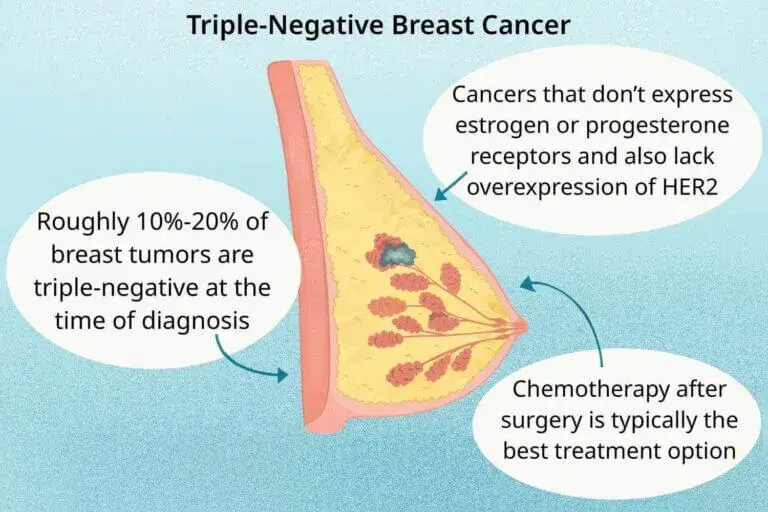
Credit (https://www.verywellhealth.com/triple-negative-breast-cancer-prognosis-4778440)
To gain a comprehensive understanding of the evolving landscape in Triple-Negative Breast Cancer (TNBC) research and development, it is crucial to examine the current state of scientific exploration and the emergence of novel treatment approaches. This insight acts as a crucial guide for making well-informed decisions in the realm of TNBC therapy, ensuring strategic choices and the effective integration of treatments within the dynamic healthcare landscape.
Market Landscape: Triple-Negative Breast Cancer (TNBC): Example Illustration: Distribution by Pipeline Candidates
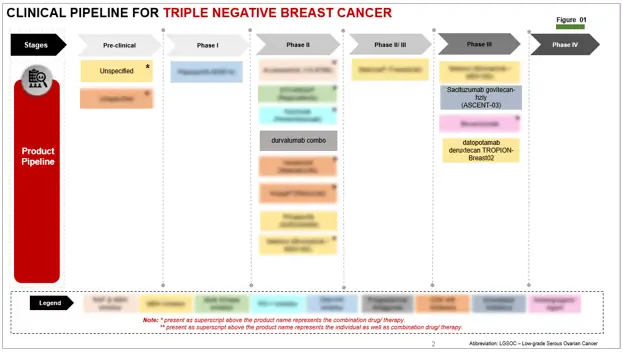
In the context of Triple-Negative Breast Cancer (TNBC) research and market analysis, company profiling assumes a pivotal role. It involves a meticulous investigation of companies engaged in the TNBC sector, providing an in-depth perspective on a company’s historical context, product range, financial resilience, competitive strategies, and recent accomplishments. This valuable data facilitates the assessment of the competitive terrain within the TNBC market, identifying prospects for collaboration and strategic partnerships that can catalyze advancements and innovation in the field.
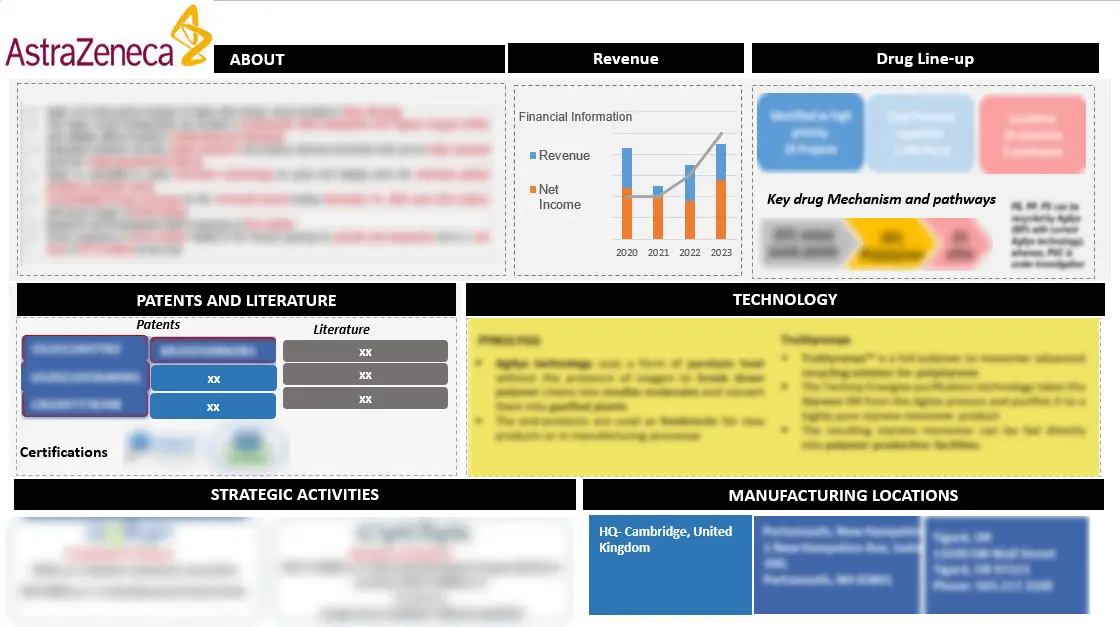
Figure 2 Company Portfolio
In this report, an exhaustive patent analysis will be undertaken to comprehensively assess the intellectual property landscape within the realm of Triple-Negative Breast Cancer (TNBC). This analysis aims to unveil significant patents, influential inventors, and emerging technological trends that are specifically pertinent to the TNBC sector.
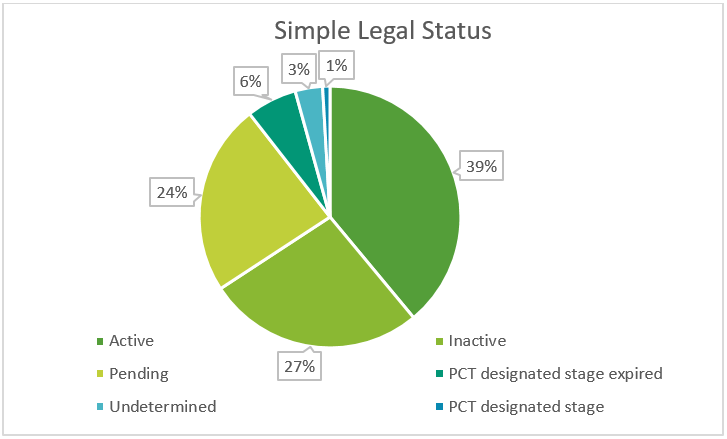
The section on clinical trial analysis within a market research report provides an in-depth assessment of clinical trials associated with Triple-Negative Breast Cancer (TNBC). This entails a thorough breakdown of trial categories, study structures, research methodologies, and participant attributes. The primary objective is to evaluate the efficacy, safety, and outcomes of pharmaceuticals and medical interventions within the context of TNBC.
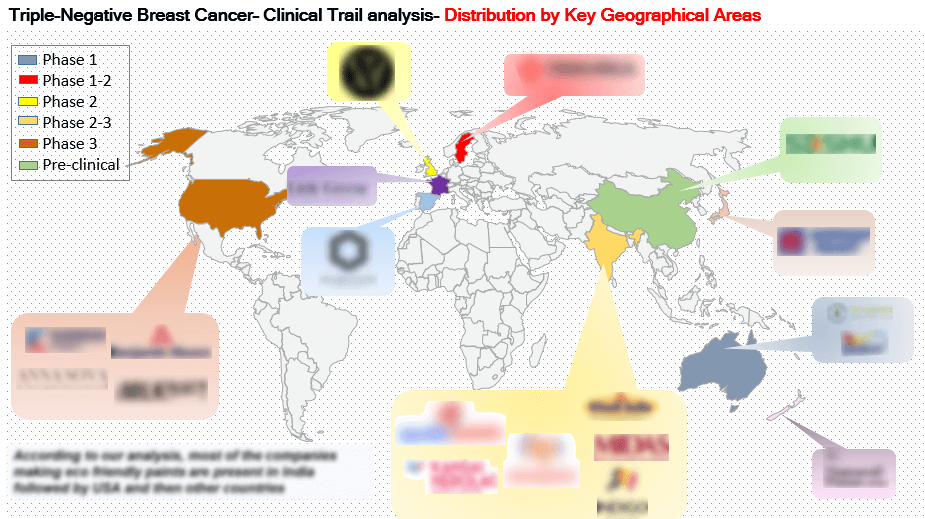
Figure 4 Distribution by Key Geographical Areas
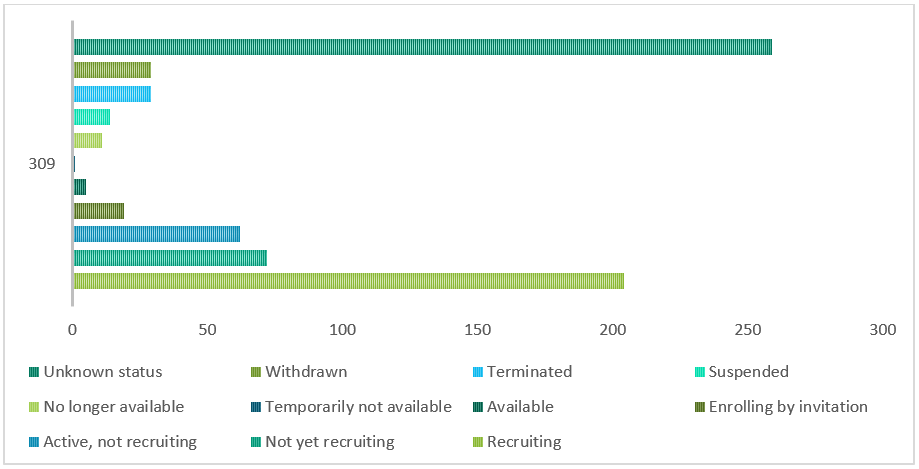
Figure 5 Distribution of TNBC Drug Clinical Trials by Status
In a market research report focused on Triple-Negative Breast Cancer (TNBC), the market forecast section delivers a comprehensive perspective on forthcoming market trends, growth prospects, and critical factors shaping supply and demand dynamics. This portion provides quantitative predictions, supplying valuable insights into TNBC’s market size, revenue forecasts, and potential pathways for growth.
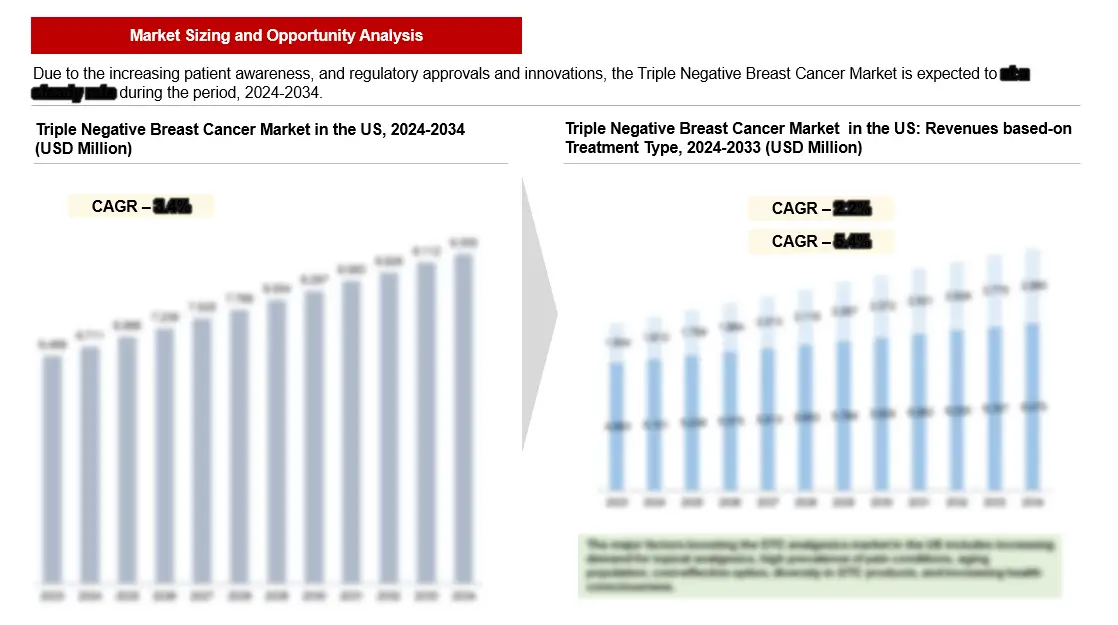
Figure 6 Market Forecast
In this market research report dedicated to Triple-Negative Breast Cancer (TNBC), the section on the competitive landscape will offer a succinct overview of prominent market players. It will include their individual market shares and provide concise profiles detailing their strengths, weaknesses, and strategic approaches within the TNBC domain.
In order to give the most precise estimations and forecasts, Wissen Research uses an extensive and iterative research approach that is focused on reducing deviation. The company blends top-down and bottom-up methodologies for market segmentation and quantitative estimation. In addition, data triangulation, which examines the market from three separate angles, is a recurrent topic present in all of our research studies. Important components of the approach used for all of our studies include the following:
Preliminary data mining
On a wide scale, unprocessed market data is collected. Continuous data filtering makes sure that only verified and authenticated sources are taken into account. Additionally, data is extracted from a wide range of reports in our repository and from a number of reputable premium databases. We gather information from raw material suppliers, distributors, and purchasers to help with this since understanding the entire value chain is crucial for a thorough understanding of the market.
Surveys, technical symposia, and trade magazines are used to gather information on technical concerns and trends. Technical information focusing on white space and freedom of movement is also obtained from an intellectual property standpoint. Additionally, information on the industry’s drivers, constraints, and pricing patterns is obtained. As a result, a variety of original data are included in the material that is then cross-validated and certified with published sources.
Statistical model
We use simulation models to generate our market projections and estimates. Every study receives a special model that is tailored to it. Data for market dynamics, the technology environment, application development, and pricing patterns are gathered and supplied into the model all at once for analysis. The relative relevance of these factors is investigated, and their impact on the forecast period is assessed, using correlation, regression, and time series analysis. The process of market forecasting combines technological analysis with economic strategies, practical business acumen, and subject expertise.
Econometric models are frequently used for short-term forecasting, but technology market models are typically employed for long-term forecasting. These are based on a confluence of the business environment, regulatory environment, economic projection, and technical landscape. In order to develop global estimates, it is preferable to estimate markets from the bottom up by integrating data from key regional markets. This is required to ensure accuracy and a complete comprehension of the subject. Among the variables taken into account for forecasting are:
Regulations and anticipated developments
We give these criteria weights and use weighted average analysis to assess their market influence in order to calculate the anticipated market growth rate.
Primary research | Secondary research |
· Manufacturers · Technology distributors and wholesalers · End-user surveys · · Consumer surveys | · Company reports and publications · Government publications · Independent investigations · Economic and demographic data · Online searches · Research reviews · Reference customers |
1. Executive Summary
1.1 Overview of Triple-Negative Breast Cancer (TNBC)
1.2 Key Findings
1.3 Market Insights
2. Introduction
2.1 Research Background
2.2 Scope and Methodology
3. Disease Overview
3.1 Definition and Classification of TNBC
3.2 Symptoms, Diagnosis, and Clinical Presentation
3.3 Pathophysiology and Genetic Basis
3.4 Epidemiology and Prevalence
3.5 Causes and Risk Factors
3.6 Treatment Types
4. Patent Analysis
4.1 Top Assignees
4.2 Geography Focus of Top Assignees
4.3 Legal Status
4.4 Geography
4.5 Assignee Segmentation
4.6 Network Analysis of Top Collaborating Entities in TNBC Treatments Patent Applications
4.7 Technology Evolution
4.8 Key Patents
4.9 Patent Trends and Innovations
4.10 Key Players and Patent Portfolio Analysis
5. Clinical Trial Analysis
5.1 Chapter Overview
5.2 Analysis by Trial Registration Year
5.3 Analysis by Phase of Development
5.4 Analysis by Number of Patients Enrolled
5.5 Analysis by Status of Trial
5.6 Analysis by Study Design
5.7 Analysis by Type of Product
5.8 Analysis by Geography
5.9 Analysis by Key Sponsors / Collaborators
6. Market Forecast (2024-2034)
6.1 Methodology
6.2 Assumptions
6.3 Projected Growth of TNBC Market (2024-2034)
6.3.1 By Drug Types
6.3.1.1 Doxorubicin
6.3.1.2 Cyclophosphamide
6.3.1.3 Paclitaxel
6.3.1.4 Docetaxel
6.3.1.5 Carboplatin/Cisplatin
6.3.1.6 Other Drug Type
6.3.2 By End Users
6.4 Market Value Forecast in North America, Europe, and Asia-Pacific (2024-2034)
6.4.1 By Drug Types
6.4.1.1 Doxorubicin
6.4.1.2 Cyclophosphamide
6.4.1.3 Paclitaxel
6.4.1.4 Docetaxel
6.4.1.5 Carboplatin/Cisplatin
6.4.1.6 Other Drug Type
6.4.2 By End Users
7. Competitive Landscape
7.1 Company Profiles
7.2 Product Portfolio Analysis
7.3 Recent Developments and Strategies
8. Future Outlook and Market Opportunities
8.1 Advancements in Research and Technology
8.2 Unmet Needs and Potential Market Gaps
8.3 Market Forecast and Growth Opportunities
9. Conclusion
10. Appendix
10.1 Glossary of Terms
10.2 List of Abbreviations
10.3 References
S.no | Key Highlights of Report | |
1. | Patent Analysis | · Top Assignee · Geography focus of top Assignees · Assignee Segmentation · Key Patents · Application and Issued Trend · Key technology |
2. | Market analysis | · Emerging Therapies and Research Developments (by product analysis and scientific analysis) · Strategic activities · Therapeutic activity of drugs · Detailed profiles of the key players that are engaged in the development of approved drugs |
3. | Clinical Trials | · Analysis of clinical trial through graphical representation · Coverage of treatments from pre-clinical phases till commercialization (also including terminated and completed studies) |
4. | Forecast | · Detailed comprehension of the historic, current and forecasted trend of market by analysis of impact of these treatments on the market |
5. | Opportunity Analysis | · Technology evolution based on problem solution · Potential licensees · Treatment trends · Unmet needs · SWOT · Drivers and barriers |
6. | KOLs | · A detailed analysis and identification of the key opinion leaders (KOLs), shortlisted based on their contributions |
LIST OF FIGURES
Figure number | Description |
Figure 1 | Terminology of Triple-Negative Breast Cancer (TNBC) Over The Years |
Figure 2 | Triple-Negative Breast Cancer (TNBC) Treatment– History and Present |
Figure 3 | Projection of Triple-Negative Breast Cancer (TNBC) till 2034 in different geographies |
Figure 4 | Technology Categorization Of Drug Delivery Methods For Triple-Negative Breast Cancer (TNBC) |
Figure 5 | Recent Technology Trends in Triple-Negative Breast Cancer (TNBC) |
Figure 6 | Technology Evolution in Drug Delivery Market of Triple-Negative Breast Cancer (TNBC) |
Figure 7 | Geographical Distribution of Patents of Top Assignees |
Figure 8 | Assignee Segmentation (Companies) |
Figure 9 | Assignee Segmentation (Educational Establishment) |
Figure 10 | Patent Based Key Insights Of xx |
Figure 11 | Patent Based Key insights of xx |
Figure 12 | Patent Based Key insights of xx |
Figure 13 | Geographic Distribution of the Universities/Research Organizations Filling Patents On Various Drug Delivery Approaches |
Figure 14 | Key Summary Regarding the Patent Filing On Triple-Negative Breast Cancer (TNBC) |
Figure 15 | Product Pipeline of Different Approaches with Companies Name |
Figure 16 | Portfolio for Approved Product |
Figure 17 | Clinical Trials Conducted till Date by Different Companies and Universities |
Figure 18 | Clinical Trials based Key Insights |
Figure 19 | Key Growth Drivers for Triple-Negative Breast Cancer (TNBC) Market |
Figure 20 | Restraints for Triple-Negative Breast Cancer (TNBC) Market |
Figure 21 | xx Portfolio (Top Player) |
Figure 22 | xx Portfolio (Top Player) |
Figure 23 | xx Portfolio (Top Player) |
Figure 24 | xx Portfolio (Top Player) |
Figure 25 | xx Portfolio (Top Player) |
Figure 26 | xx Portfolio (Start-up) |
Figure 27 | xx Portfolio (Start-up) |
Figure 28 | xx Portfolio (Start-up) |
Figure 29 | Strategic Activities Including Collaboration, Partnerships and Acquisitions |
Figure 30 | Research Methodology for Patent, Selection and Analysis |
Figure 31 | Research Methodology for Clinical Trials, Selection and Analysis |
LIST OF GRAPHS
Graph number |
Description |
Graph 1 | Number of people worldwide with Triple-Negative Breast Cancer (TNBC) |
Graph 2 | Problem Solution Analysis |
Graph 3 | Top Assignees in Triple-Negative Breast Cancer (TNBC) |
Graph 4 | Technology Focus of Top Assignees (IPC-CPC Classes) |
Graph 5 | Top Countries of Origin of Patents |
Graph 6 | New entrants in drug delivery field |
Graph 7 | Legal Status |
Graph 8 | Most Cited Patents |
Graph 9 | Patents with Largest Invention Families |
Graph 10 | Most Claim-Heavy Patents |
Graph 11 | Filing Trends |
Graph 12 | Clinical Trial Filing Timeline |
Graph 13 | Recruitment Status of the Clinical Trials Related to the Different Drug Delivery Approaches |
Graph 14 | Clinical Trials Phases with Respect to Specific Drug Delivery Approach |
Graph 15 | Weighted Scores for Top 5 Players According to Benchmarking Criteria |
Graph 16 | Triple-Negative Breast Cancer (TNBC) (CAGR: 2024-2034) |
Graph 17 | Triple-Negative Breast Cancer (TNBC) Market Share: Distribution by Key Geographical Area, 2024-2034 |
LIST OF TABLES
Table number | Description |
Table 1 | Parameters included and excluded for conducting the analysis |
Table 2 | Technology Classes with Definitions |
Table 3 | Patent Litigation |
Table 4 | Highest Market Valued Patents |
Table 5 | SWOT Analysis of Top 3 Players |
Table 6 | Parameters and their score for Benchmarking |
Table 7 | Weighted scores for top 5 players according to benchmarking criteria |
© Copyright 2024 – Wissen Research All Rights Reserved.